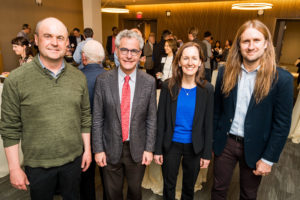Solutions to challenges in the chemical sciences
Alumni and friends enjoyed an evening of food, drink, and talks by Associate Professor Elizabeth M. Nolan and Associate Professor Jeremiah Johnson

Department Head Timothy Jamison, Dean Michael Sipser, and Associate Professors of Chemistry Elizabeth Nolan and Jeremiah Johnson enjoy the reception. Photo: Justin Knight
The Department of Chemistry was pleased to co-host its third annual Alumni and Friends reception with the School of Science. Invited guests gathered in the Samberg Conference Center for an evening of food, drink, and talks by Associate Professors Elizabeth Nolan and Jeremiah Johnson, who shared how their research addresses some of the greatest challenges currently faced by the chemical sciences.
Employing metal withholding to inhibit microbial colonization
Nolan studies the chemistry and biology of human innate immunity and microbial pathogenesis, with a focus on the role of transition metals in the interplay between human host-defense molecules and microbes. Since transition metal ions are essential nutrients for all organisms, including microbes, mammalian cells employ proteins to sequester inorganic nutrients — such as manganese, iron, and zinc — in extracellular space and thus starve invading pathogens.
Nolan shared her research on human calprotectin (CP), which is one of these metal-sequestering proteins. CP, produced by white blood cells called neutrophils, is implicated in a variety of pathophysiological conditions that range from cardiovascular disease to cancer, and is an FDA-approved biomarker for inflammatory conditions of the bowels. By working to elucidate CP’s biological coordination chemistry, role in metal homeostasis, and lifetime and fate in the biological milieu, Nolan hopes to provide a foundation for evaluating how CP plays a role in human disease.
“I am fascinated by chemistry and biology and the natural world,” said Nolan. “Studying the bioinorganic chemistry of the host/microbe interaction and infectious disease interfaces concepts and toolkits from many different disciplines and provides opportunities to contribute out-of-the-box ideas for both fundamental research and non-traditional ways to approach the prevention and treatment of infectious disease.”
New synthetic strategies for macromolecules
Professor Jeremiah Johnson’s group seeks to develop new methodologies for the construction and modification of complex material libraries. Iterative library synthesis, function-based screening, and design optimization will ultimately yield basic knowledge, such as structure-function relationships for materials in specific applications, and new materials-based technologies that outperform current alternatives.
Johnson presented his group’s efforts to develop a drug-agnostic materials platform that can enable the rapid improvement of the therapeutic index for drugs with known targets and established efficacy but poor safety profiles.
“Accomplishing this goal would allow us to rescue drugs that are stalled in early clinical trials due to unmanageable side effects, or to utilize already approved drugs in new ways,” he explained.
To achieve this goal, Johnson develops methods for the controlled and scalable synthesis of large molecules, which are also known as macromolecules. Johnson presented a new synthetic strategy that can enable the kilo-scale synthesis of macromolecular prodrug scaffolds with tunable size and drug release kinetics. These materials can be employed to treat diseases ranging from cancer to liver fibrosis.
Celebrating basic science
As in years past, this event proved to be an excellent opportunity to showcase a sampling of the revolutionary work being conducted within the halls of the Department of Chemistry and the MIT campus as a whole.
“I personally cherish any opportunity I get to hear my colleagues present their research first-hand,” said Department Head Timothy F. Jamison. “Institutions around the world have that privilege way more often than we ever have at ‘home!’ I am especially delighted that you were able to join us this evening to meet professors Nolan and Johnson and to learn about their spectacular research.”
The full version of this article appeared at news.mit.edu on May 25, 2018.